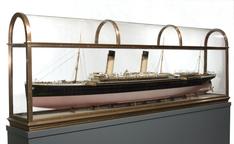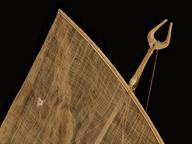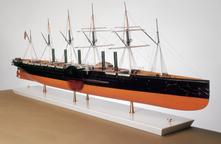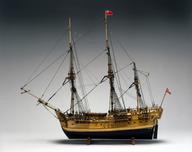


This Lintott Standard Underwater Research Vehicle (SURV) is a private manned mini submersible built in 1967 by Lintott Engineering Limited in Sussex.
The craft is held upright by a supporting steel frame (built by the SMG), but the vehicle itself has a vertical cylinder steel and fibreglass body that is 11 feet long, 6 feet wide and 9 feet high, and weights approximately 6 tons.
The vehicle was powered by a series of lead-acid batteries, and whilst underwater the SURV was manoeuvred and directed by a set of two rotatable propellor pods. For emergencies a quarter ton of emergency ballast was installed.
The Lintott Standard Underwater Research Vehicle (SURV) is a private manned mini submersible built in 1967 by Lintott Engineering Limited in Sussex.
The SURV was the first privately designed, British, manned deep sea research vehicle built for the commercial market. The vehicle was designed to be manned by a crew of two and could stay submerged for up to 36 hours at depths of between 600 and 1000 feet and could reach a maximum speed of around two-and-a-half knots using its battery-powered propellers. The craft could also be equipped with manipulative arms which could be controlled within the craft. Observation from the SURV was provided by ten Perspex portholes around the vehicle.
The purpose of the SURV was to be leased or bought for use inspecting and collecting geological and biological samples; performing offshore experiments; supporting and repairing oilrigs; performing rescue and salvage operations; laying underwater cables; or for deep sea exploration.
It was noted at the time for having a relatively lightweight fibreglass shell design, weighing only approximately six tons which allowed it to be transported by air when necessary. This design also made this deep research vehicle cheaper to run and operate and could be sold or rented for one third of the price of competing U.S and Canadian research submersibles. By 1969, leasing the SURV, along with its support ship, cost approximately $2400 a day.
Whilst the SURV’s innovative design was successfully tested through various trials carried out in 1967 and 1968, it failed to attract enough market interest for its sale or leased services to be financially sustainable. The SURV was subsequently retired from operation by Lintott in 1969 after only two years. The development of a successor, the SURV II, was initiated not long after, but these plans were also put on indefinite hold.
Details
- Category:
- Water Transport
- Object Number:
- 1977-629
- Materials:
- steel (metal), fibreglass, plastic (unidentified), rubber (unidentified), glass and paint
- Measurements:
-
overall: 3320 mm x 2090 mm x 4240 mm, 6 t
- credit:
- Lintott Engineering Ltd.




